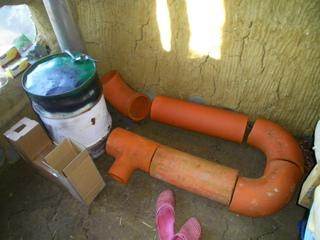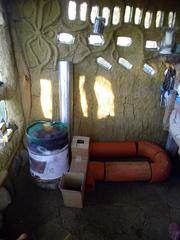






allen lumley wrote:Right now you are getting some of the coldest temps ,in a basically Maritime Climate ? Right ? and it will be 3-4 months until things warm up !
allen lumley wrote:1st thought Casually introduce the idea in ALL conversations with neighbors and friend of Neighbors that you are Adding a simple forge into your Work space in your
garden shed, And will probably have to move it outside when it warms up !
allen lumley wrote:I see about 3 rocket mass heater builds in your future ! The simplest build and easiest to live with is a J-Bend, Vertical feed, (150mm ) 6'' Rocket Mass Heater RMH. This is the Space heater that you learn on !
allen lumley wrote: After you have mastered the 6'' system it will be possible to talk about attempting to build a 4'' system - Newer adaptations
of this RMH Include a horizontal fed batch loaded 4'' that when built correctly can perform as well as the 6'' - However experience is the only way that can give you the
hands on experience that you need to move up to a 4'' system - many people who try to build a 4'' RMH (100mm) as a 1st build Fail and then we have to deal with the
" I tried that - '' ''It doesn't work'' '' Its a bunch of Tripe " fail out !
allen lumley wrote: Now the Thermal mass Thing- I hope that I can encourage you to take another look at its practicality ! All we want to do is raise your bed up off of the floor and place a
heated Mattress Pad or possibly a futon pad ! when you want just the bed warn you keep the covers on when you want the whole space warmed say during bathing you
remove the covers and let the room warm ! Actually Elevating your bed will reduce the need for supplementary heat - Did I mention that your Thermal Mass can be
used to store Coolth for you ?
allen lumley wrote: If you have not already done so Borax can be sprinkled into your bedding to reduce a fire hazard and Baking Soda makes a good fire extinguisher for wood and oil/
grease fires !
allen lumley wrote:
Fire bricks - O.K. Thats an issue, Our fallback position is 100 year-old dead-soft Red or orange red house bricks, This kind if rubbed on a sidewall (or concrete ) will
leave a mark behind in the same way that Chalk leaves its mark behind on a Sidewalk ! This is an adequate Feed Tube and Burn Tunnel for a Vertically fed J-Bend Style
6''RMH
allen lumley wrote:
Perlite : Have you checked local green houses for horticultural penlight? Vermiculite , or pumice , or expanded Clay pellets can be made to work ! ( I'm counting on
otherMembers to chime in here )


Emily Aaston wrote:
We also decided to build the core entirely out of cob (heavy on perlite for the burn tunnel and heat riser). Unfortunately, we were in such a hurry that the manifold and heat riser collapses on us the night before the chicks were to arrive. But we decided to buy two more pieces of stove-pipe that was filled with perlite-cob to replace our heat riser and after a week or so of burning the heater, it was dry and ready for our chicks!